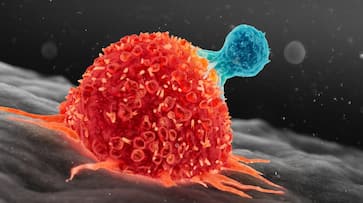In a groundbreaking discovery that holds potential for new cancer therapies, scientists from the Indian Institute of Science (IISc) have uncovered a novel genetic mechanism related to protein production in cells that could help curb cancer cell growth.
In a groundbreaking discovery that holds potential for new cancer therapies, scientists from the Indian Institute of Science (IISc) have uncovered a novel genetic mechanism related to protein production in cells that could help curb cancer cell growth. The research team, led by Dr. Sandeep Eswarappa from IISc’s Department of Biochemistry (BC), has found that a phenomenon known as "stop codon readthrough" in the FEM1B gene promotes cancer cell proliferation by disrupting normal protein regulation. Their study has been published in the Journal of Cell Science.
The key finding centers on how the "readthrough" process allows cells to bypass the usual stop signals in protein synthesis, leading to the production of altered proteins that drive uncontrolled cell growth — a hallmark of cancer. This genetic bypass, which was found specifically in the FEM1B gene, may play a crucial role in tumor growth, offering potential new avenues for cancer treatment.
Mechanism of stop codon readthrough
During the normal process of protein synthesis, genetic information stored in mRNA (messenger RNA) directs the formation of proteins by assembling amino acids, the building blocks of life. Each three-nucleotide sequence, known as a codon, encodes for a specific amino acid, while certain codons signal the start and end of this process. However, the IISc team found that in some cases, this precise sequence is interrupted. The machinery that assembles proteins may skip the stop codon, resulting in a longer-than-expected protein being produced — a phenomenon termed as “stop codon readthrough.”
“Because of that extra appendage, the protein can have a different localisation, a different stability, it can even have a different function," Dr. Eswarappa was quoted as saying in a Time of India report.
The research zeroed in on the FEM1B gene, which encodes a protein involved in tagging other proteins for degradation, an essential process for regulating the cell cycle and preventing unchecked cell growth. However, when stop codon readthrough occurs in the FEM1B gene, the resulting protein becomes longer and more unstable, ironically marking itself for degradation instead of performing its usual regulatory function. This destabilization leads to reduced levels of FEM1B protein, enabling cancer cells to proliferate more rapidly.
Our study has identified a relatively recently evolved oncogenic translational event that may partly explain why humans are more susceptible to cancer among primates. https://t.co/XuVNhX0EF0@EswarappaLab @J_Cell_Sci@iiscbangalore @BICS_IISc @SandeepME_IISc pic.twitter.com/ef8WABPLJF
— Noor Akhtar (@nrakhtar3284) August 22, 2024
Impact of cancer cell growth
The study revealed that this faulty process had significant implications for cancer biology. In a lab setting, the research team used CRISPR-Cas9 gene-editing technology to cut off the sequence responsible for driving the readthrough from the FEM1B gene in cancer cell lines. This disruption prevented the readthrough process, resulting in higher levels of the FEM1B protein, which in turn enhanced the degradation of other key proteins involved in cell growth regulation. As a result, cancer cells exhibited slower proliferation, suggesting that targeting this genetic mechanism could potentially control tumor growth.
Md Noor Akhtar, the lead author of the study and an integrated PhD student in Eswarappa’s lab, highlighted the clinical relevance of these findings. When the team injected cancer cells with a defective readthrough process into mice, the tumors grew more slowly, suggesting that controlling this mechanism might offer a new approach to cancer therapy.
Evolutionary link and human cancer susceptibility
The study also ventured into evolutionary biology to explore the origins of this genetic anomaly. The researchers discovered that the stop codon readthrough process in the FEM1B gene is unique to humans and chimpanzees, suggesting that it emerged about 10 million years ago when these species branched off from other primates. This tiny evolutionary change, a single nucleotide insertion downstream of the first stop codon, may have inadvertently increased susceptibility to cancer in humans compared to other primates.
Additionally, the team analyzed publicly available datasets of cancer patients and found that higher expression levels of the FEM1B gene were linked to improved survival rates, further supporting their hypothesis that regulating the readthrough process could have therapeutic implications.
Future directions and therapeutic potential
Despite the promising discoveries, the team remains puzzled by the exact mechanisms underlying the stop codon readthrough process. Dr. Eswarappa emphasized the importance of identifying the molecular machinery involved in this genetic bypass, which would help in developing more targeted and effective cancer treatments. “If we know the mechanism, we can target and regulate the readthrough process, which in turn might help in controlling the tumor progression," he said.
The discovery opens up exciting possibilities for cancer research, particularly in developing therapies that could control or reverse the readthrough process in cancer cells. By restoring normal protein regulation, scientists hope to inhibit the unchecked growth of cancerous cells, offering a novel approach to combat the disease.
Last Updated Sep 9, 2024, 6:04 PM IST









![Salman Khan sets stage on fire for Anant Ambani, Radhika Merchant pre-wedding festivities [WATCH] ATG](https://static-gi.asianetnews.com/images/01hr1hh8y86gvb4kbqgnyhc0w0/whatsapp-image-2024-03-03-at-12-24-37-pm_100x60xt.jpg)
![Pregnant Deepika Padukone dances with Ranveer Singh at Anant Ambani, Radhika Merchant pre-wedding bash [WATCH] ATG](https://static-gi.asianetnews.com/images/01hr1ffyd3nzqzgm6ba0k87vr8/whatsapp-image-2024-03-03-at-11-45-35-am_100x60xt.jpg)


